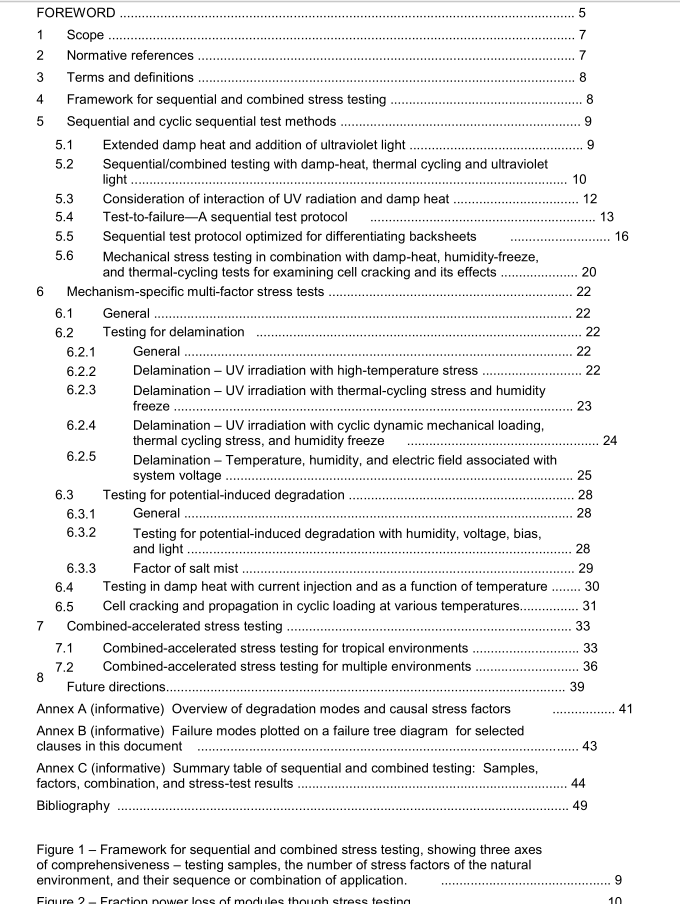IEC TR 63279 pdf – Derisking photovoltaic modules – Sequential and combined accelerated stress testing

IEC TR 63279 pdf – Derisking photovoltaic modules – Sequential and combined accelerated stress testing
1 Scope
This document reviews research into sequential and combined accelerated stress tests thathave been devised to determine the potential for degradation modes in PV modules that occur
in the field that single-factor and steady-state tests do not show. This document is intended to
provide data and theory-based motivation and help visualize the next steps for improvedaccelerated stress tests that will derisk PV module materials and designs. Any incrementalsavings as a result of increased reliability and reduced risk translates into lower levelized cost
of electricity for PV.Lower costs will result in faster adoption of PV and the associated benefitsof renewable energy.
2Normative references
The following documents are referred in the text in such a way that some or all of their contentconstitutes requirements of this document. For dated references,only the edition cited applies.
For undated references,the latest edition of the referenced document(including anyamendments) applies.
IEC 60721-2-1,Classification of environmental conditions – Part 2-1:Environmental conditionsappearing in nature – Temperature and humidity
IEC 61215-1:2016,Terrestrial photovoltaic (PV) modules – Design qualification and typeapproval-Part 1: Test requirements
IEC61215-2:2016,Terrestrial photovoltaic(Pv) modules – Design qualification and typeapproval- Part 2: Test procedures
IEC 61730-2:2016,Photovoltaic(PV)module safety qualification – Part 2:Requirements fortesting
IEC TS 61836,Solar photovoltaic energy systems -Terms, definitions and symbols
IEC TS 62782:2016,Photovoltaic(PV) modules – Cyclic (dynamic) mechanical load testingIEC 62788 (all parts), Measurement procedures for materials used in photovoltaic modules
IEC TS 62804-1,Photovoltaic(Pv)modules – Test methods for the detection of potential-induced degradation – Part 1: Crystaline silicon
IEC TS 62804-1-1,Photovoltaic (PV) modules – Test methods for the detection of potential-induced degradation – Part 1-1: Crystalline silicon – Delamination
ASTM D7869-17 Standard Practice for Xenon Arc Exposure Test with Enhanced Light andwater Exposure for Transportation Coatings
3 Terms and definitions
For the purposes of this document, the terms and definitions given in IEC TS 61836 apply.
ISO and IEC maintain terminological databases for use in standardization at the following addresses:
IEC Electropedia: available at http://www.electropedia.org/
ISO Online browsing platform: available at http://www.iso.org/obp
4 Framework for sequential and combined stress testing A number of researchers, companies and testing laboratories have explored aspects of sequential and combined stress testing to fill outstanding needs. Such needs include testing beyond IEC 61215-2, which for the most part does not purport to examine for end-of-life wear- out and failure mechanisms. In other cases, stresses are sequenced and combined to elicit failure modes that have been seen in the field that existing IEC tests may not evaluate. A framework for organization is proposed that implements stress factors of the natural environment, sequences and combinations of applying them, and sample types that may be employed for evaluation. To illustrate this, Figure 1 is introduced, which gives a three- dimensional plot with the axes of sample, factor, and combination, that together indicate the comprehensiveness of test methods to represent the effects of the natural environment on the sample in accelerated testing. First the sample comprehensiveness axis of Figure 1 is discussed.
As a new material is explored, the material itself is studied to achieve a basic understanding of its intrinsic degradation mechanisms and durability. Thus, material and coupon tests as they are performed now according to IEC 62788 series material tests will be valuable. However, failures often occur at the interfaces between materials, and the performance of one component of the module often depends on the behaviour of another component or material in the assembly. Therefore, to represent the material interactions, boundary conditions in actual use, and stresses experienced, it is necessary to examine mini-modules, and most comprehensively, full-size modules with all their components. Next the factors comprehensiveness axis is discussed. This is the number of stress factors of the natural environment applied in testing of the sample. Moving from single stress factor tests to multi-factor tests increases confidence of capturing the factors relevant to both known and unknown degradation modes. Using one factor alone may be useful to evaluate an acceleration factor or an activation energy associated with that stress for a specific degradation mode or mechanism that is already understood to depend principally on that stress factor independently of others.









